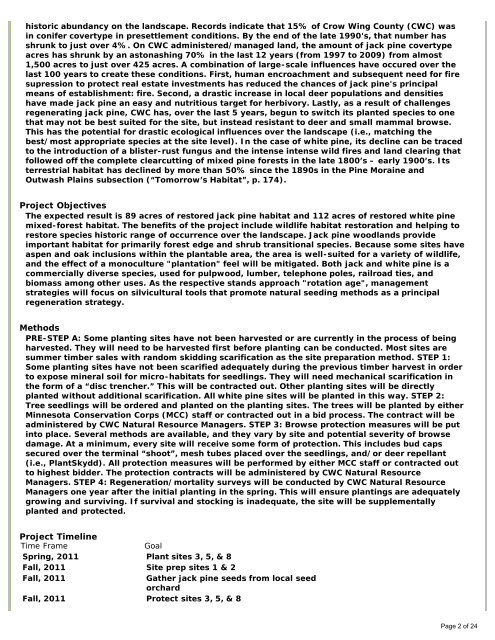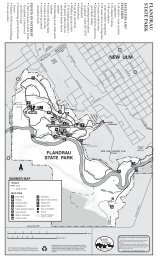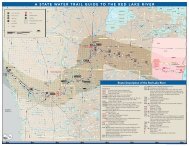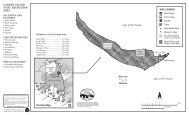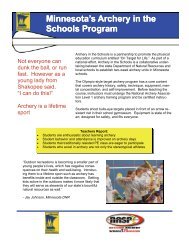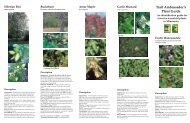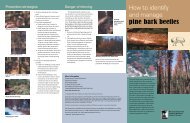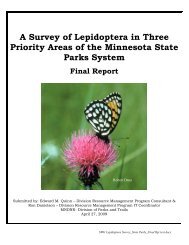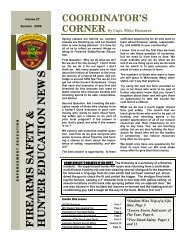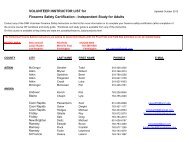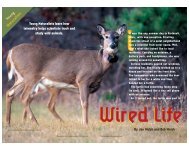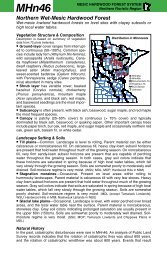Conservation Partners Legacy Grant Application - Minnesota ...
Conservation Partners Legacy Grant Application - Minnesota ...
Conservation Partners Legacy Grant Application - Minnesota ...
Create successful ePaper yourself
Turn your PDF publications into a flip-book with our unique Google optimized e-Paper software.
historic abundancy on the landscape. Records indicate that 15% of Crow Wing County (CWC) was<br />
in conifer covertype in presettlement conditions. By the end of the late 1990's, that number has<br />
shrunk to just over 4%. On CWC administered/managed land, the amount of jack pine covertype<br />
acres has shrunk by an astonashing 70% in the last 12 years (from 1997 to 2009) from almost<br />
1,500 acres to just over 425 acres. A combination of large-scale influences have occured over the<br />
last 100 years to create these conditions. First, human encroachment and subsequent need for fire<br />
supression to protect real estate investments has reduced the chances of jack pine's principal<br />
means of establishment: fire. Second, a drastic increase in local deer populations and densities<br />
have made jack pine an easy and nutritious target for herbivory. Lastly, as a result of challenges<br />
regenerating jack pine, CWC has, over the last 5 years, begun to switch its planted species to one<br />
that may not be best suited for the site, but instead resistant to deer and small mammal browse.<br />
This has the potential for drastic ecological influences over the landscape (i.e., matching the<br />
best/most appropriate species at the site level). In the case of white pine, its decline can be traced<br />
to the introduction of a blister-rust fungus and the intense intense wild fires and land clearing that<br />
followed off the complete clearcutting of mixed pine forests in the late 1800’s – early 1900’s. Its<br />
terrestrial habitat has declined by more than 50% since the 1890s in the Pine Moraine and<br />
Outwash Plains subsection (“Tomorrow’s Habitat”, p. 174).<br />
Project Objectives<br />
The expected result is 89 acres of restored jack pine habitat and 112 acres of restored white pine<br />
mixed-forest habitat. The benefits of the project include wildlife habitat restoration and helping to<br />
restore species historic range of occurrence over the landscape. Jack pine woodlands provide<br />
important habitat for primarily forest edge and shrub transitional species. Because some sites have<br />
aspen and oak inclusions within the plantable area, the area is well-suited for a variety of wildlife,<br />
and the effect of a monoculture "plantation" feel will be mitigated. Both jack and white pine is a<br />
commercially diverse species, used for pulpwood, lumber, telephone poles, railroad ties, and<br />
biomass among other uses. As the respective stands approach "rotation age", management<br />
strategies will focus on silvicultural tools that promote natural seeding methods as a principal<br />
regeneration strategy.<br />
Methods<br />
PRE-STEP A: Some planting sites have not been harvested or are currently in the process of being<br />
harvested. They will need to be harvested first before planting can be conducted. Most sites are<br />
summer timber sales with random skidding scarification as the site preparation method. STEP 1:<br />
Some planting sites have not been scarified adequately during the previous timber harvest in order<br />
to expose mineral soil for micro-habitats for seedlings. They will need mechanical scarification in<br />
the form of a “disc trencher.” This will be contracted out. Other planting sites will be directly<br />
planted without additional scarification. All white pine sites will be planted in this way. STEP 2:<br />
Tree seedlings will be ordered and planted on the planting sites. The trees will be planted by either<br />
<strong>Minnesota</strong> <strong>Conservation</strong> Corps (MCC) staff or contracted out in a bid process. The contract will be<br />
administered by CWC Natural Resource Managers. STEP 3: Browse protection measures will be put<br />
into place. Several methods are available, and they vary by site and potential severity of browse<br />
damage. At a minimum, every site will receive some form of protection. This includes bud caps<br />
secured over the terminal “shoot”, mesh tubes placed over the seedlings, and/or deer repellant<br />
(i.e., PlantSkydd). All protection measures will be performed by either MCC staff or contracted out<br />
to highest bidder. The protection contracts will be administered by CWC Natural Resource<br />
Managers. STEP 4: Regeneration/mortality surveys will be conducted by CWC Natural Resource<br />
Managers one year after the initial planting in the spring. This will ensure plantings are adequately<br />
growing and surviving. If survival and stocking is inadequate, the site will be supplementally<br />
planted and protected.<br />
Project Timeline<br />
Time Frame<br />
Goal<br />
Spring, 2011 Plant sites 3, 5, & 8<br />
Fall, 2011 Site prep sites 1 & 2<br />
Fall, 2011<br />
Gather jack pine seeds from local seed<br />
orchard<br />
Fall, 2011 Protect sites 3, 5, & 8<br />
Page 2 of 24


